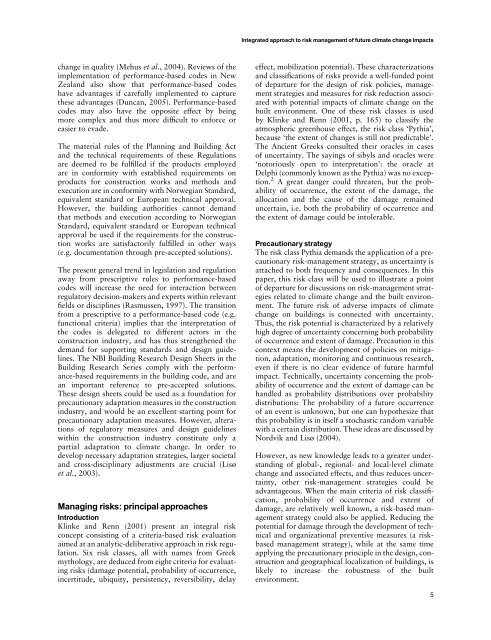Lisø PhD Dissertation Manuscript - NTNU
Lisø PhD Dissertation Manuscript - NTNU
Lisø PhD Dissertation Manuscript - NTNU
You also want an ePaper? Increase the reach of your titles
YUMPU automatically turns print PDFs into web optimized ePapers that Google loves.
change in quality (Mehus et al., 2004). Reviews of the<br />
implementation of performance-based codes in New<br />
Zealand also show that performance-based codes<br />
have advantages if carefully implemented to capture<br />
these advantages (Duncan, 2005). Performance-based<br />
codes may also have the opposite effect by being<br />
more complex and thus more difficult to enforce or<br />
easier to evade.<br />
The material rules of the Planning and Building Act<br />
and the technical requirements of these Regulations<br />
are deemed to be fulfilled if the products employed<br />
are in conformity with established requirements on<br />
products for construction works and methods and<br />
execution are in conformity with Norwegian Standard,<br />
equivalent standard or European technical approval.<br />
However, the building authorities cannot demand<br />
that methods and execution according to Norwegian<br />
Standard, equivalent standard or European technical<br />
approval be used if the requirements for the construction<br />
works are satisfactorily fulfilled in other ways<br />
(e.g. documentation through pre-accepted solutions).<br />
The present general trend in legislation and regulation<br />
away from prescriptive rules to performance-based<br />
codes will increase the need for interaction between<br />
regulatory decision-makers and experts within relevant<br />
fields or disciplines (Rasmussen, 1997). The transition<br />
from a prescriptive to a performance-based code (e.g.<br />
functional criteria) implies that the interpretation of<br />
the codes is delegated to different actors in the<br />
construction industry, and has thus strengthened the<br />
demand for supporting standards and design guidelines.<br />
The NBI Building Research Design Sheets in the<br />
Building Research Series comply with the performance-based<br />
requirements in the building code, and are<br />
an important reference to pre-accepted solutions.<br />
These design sheets could be used as a foundation for<br />
precautionary adaptation measures in the construction<br />
industry, and would be an excellent starting point for<br />
precautionary adaptation measures. However, alterations<br />
of regulatory measures and design guidelines<br />
within the construction industry constitute only a<br />
partial adaptation to climate change. In order to<br />
develop necessary adaptation strategies, larger societal<br />
and cross-disciplinary adjustments are crucial (<strong>Lisø</strong><br />
et al., 2003).<br />
Managing risks: principal approaches<br />
Introduction<br />
Klinke and Renn (2001) present an integral risk<br />
concept consisting of a criteria-based risk evaluation<br />
aimed at an analytic-deliberative approach in risk regulation.<br />
Six risk classes, all with names from Greek<br />
mythology, are deduced from eight criteria for evaluating<br />
risks (damage potential, probability of occurrence,<br />
incertitude, ubiquity, persistency, reversibility, delay<br />
Integrated approach to risk management of future climate change impacts<br />
effect, mobilization potential). These characterizations<br />
and classifications of risks provide a well-funded point<br />
of departure for the design of risk policies, management<br />
strategies and measures for risk reduction associated<br />
with potential impacts of climate change on the<br />
built environment. One of these risk classes is used<br />
by Klinke and Renn (2001, p. 165) to classify the<br />
atmospheric greenhouse effect, the risk class ‘Pythia’,<br />
because ‘the extent of changes is still not predictable’.<br />
The Ancient Greeks consulted their oracles in cases<br />
of uncertainty. The sayings of sibyls and oracles were<br />
‘notoriously open to interpretation’: the oracle at<br />
Delphi (commonly known as the Pythia) was no exception.<br />
2 A great danger could threaten, but the probability<br />
of occurrence, the extent of the damage, the<br />
allocation and the cause of the damage remained<br />
uncertain, i.e. both the probability of occurrence and<br />
the extent of damage could be intolerable.<br />
Precautionary strategy<br />
The risk class Pythia demands the application of a precautionary<br />
risk-management strategy, as uncertainty is<br />
attached to both frequency and consequences. In this<br />
paper, this risk class will be used to illustrate a point<br />
of departure for discussions on risk-management strategies<br />
related to climate change and the built environment.<br />
The future risk of adverse impacts of climate<br />
change on buildings is connected with uncertainty.<br />
Thus, the risk potential is characterized by a relatively<br />
high degree of uncertainty concerning both probability<br />
of occurrence and extent of damage. Precaution in this<br />
context means the development of policies on mitigation,<br />
adaptation, monitoring and continuous research,<br />
even if there is no clear evidence of future harmful<br />
impact. Technically, uncertainty concerning the probability<br />
of occurrence and the extent of damage can be<br />
handled as probability distributions over probability<br />
distributions: The probability of a future occurrence<br />
of an event is unknown, but one can hypothesize that<br />
this probability is in itself a stochastic random variable<br />
with a certain distribution. These ideas are discussed by<br />
Nordvik and <strong>Lisø</strong> (2004).<br />
However, as new knowledge leads to a greater understanding<br />
of global-, regional- and local-level climate<br />
change and associated effects, and thus reduces uncertainty,<br />
other risk-management strategies could be<br />
advantageous. When the main criteria of risk classification,<br />
probability of occurrence and extent of<br />
damage, are relatively well known, a risk-based management<br />
strategy could also be applied. Reducing the<br />
potential for damage through the development of technical<br />
and organizational preventive measures (a riskbased<br />
management strategy), while at the same time<br />
applying the precautionary principle in the design, construction<br />
and geographical localization of buildings, is<br />
likely to increase the robustness of the built<br />
environment.<br />
5














![Diagnosis and FTC by Prof. Blanke [pdf] - NTNU](https://img.yumpu.com/12483948/1/190x245/diagnosis-and-ftc-by-prof-blanke-pdf-ntnu.jpg?quality=85)

